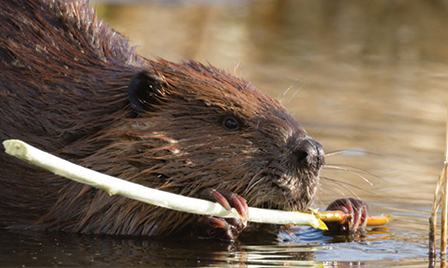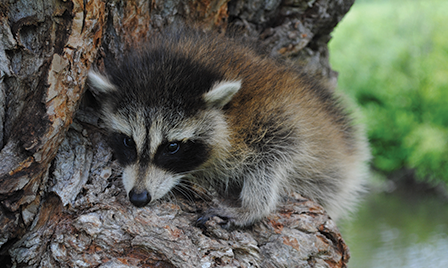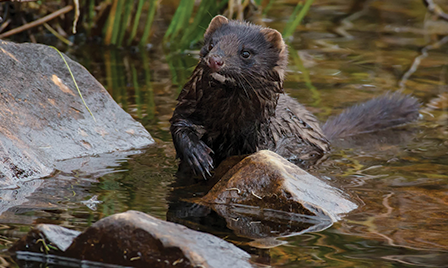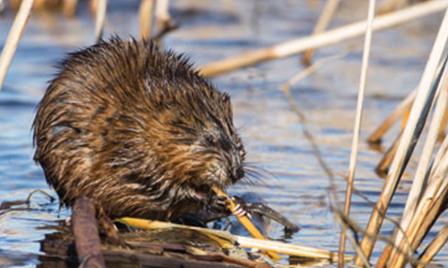Otter Identification
River Otter Information:
Click on the following links to learn more:
Identification
Although river otters spend a large part of their time in the water of lakes, rivers, and streams, they frequently leave the water providing several forms of evidence of their presence.
Tracks
River otter tracks are probably the most abundant form of evidence and are easily identified. Typically, the forefoot measures 2-3 inches wide, and 3-4 inches long; the hind foot measures 3-4 inches wide and 4-5 inches long. Otter tracks are similar to others in the weasel family. Tracks are asymmetrical, with five toes, claws, and a c-shaped palm. In the natural environment, not all of these features are always seen in otter tracks due to variation in substrate (ground) conditions. Often, tracks will show four toes instead of 5, or have no claw marks present.
Slides, Trails, and Tail Drags
Otter slides and tail drags are often useful to confirm their presence. Slides are often 6-10 inches wide, can vary in length, and are mostly found near water. When sliding uphill, the slide will be punctuated by track marks. On downhill slides, the slide will be continuous. Tail drags
occur when the otter is walking or galloping. When tail drags are present, there will be a line approximately 12 inches in length and wider at base and slimmer at the tip accompanying the tracks. Because otters are highly social it is common to see more than one set of tracks or slides at a location. It must be noted that otters will use beaver slides when available which have similar characteristics to otter slides. Examination of the area around slide usually yields tracks, scat, or feeding sign that help identify which species are currently in the area.
Scat
Otter scat is typically found along waterways, on logs, or in communal latrines (i.e., areas where multiple otters defecate). A distinguishing factor that helps to distinguish otter scat from that of other animals is that otter scat is generally packed with fish scales, crayfish exoskeletons, bones, and other undigested animal material. Otter scat can occasionally be confused with raccoon (Procyon lotor) and coyote (Canis latrans) scat, but there are distinctive characteristics between each species’ scat. Since otters are strictly carnivores (while raccoon and coyotes are omnivores), you will never find berries or other plant materials in otter scat. Raccoon scat, in contrast, will commonly contain berries or other plant material. Coyotes, while omnivorous, are typically distinguished from otters from the high abundance of fur in their scat. Although rare, otters might opportunistically consume a small aquatic mammal; regardless, otter scat will not contain fur in the abundance of that in coyote scat.
Species Often Confused with River Otters:
Beavers
Beavers are confused with otters because beavers and otters look alike while swimming, and both leave slides along the banks. When swimming, beavers have their backs and head out of the water, while river otters have just their head and neck above the water’s surface. Slides can be almost indistinguishable, but chewed trees and sticks are a telltale sign of a beaver, while fish heads are indicative of otters. Beaver scat is easily distinguished from otter scat by its lack of fish scales and crayfish remains, cylindrical shape, and often sawdust like texture. In addition, both beaver and otter tails are flattened; however, beaver tails are flattened like a wide, rounded paddle, while otter tails are much narrower, taper to a point, and are covered with fur.

Raccoon
As mentioned previously, raccoons and otters have scat that resembles one another. Raccoon scat, however, will consist of berries and other vegetation while otter scat is primarily composed of fish scales, especially in the winter months. Raccoon tracks can be distinguished by their shape (raccoon tracks often resemble pointed hands or a five-pointed flipper), and otters, unlike raccoons, have webbing between their toes which can be present in an otter track.

Mink
Because mink and otters are in the same family (Mustelidae), they highly resemble each other. To tell these two species apart, size is the most important factor. Otters are large, almost 4 feet long, while mink are significantly smaller, measuring less than 2 feet in length. Mink tracks will also resemble those of otters in appearance, however they are much smaller (up to 2in x 2in). Additionally, the tails of mink are short and slightly bushy; whereas, otter tails are long, sleek, and tapered.

Muskrat
Muskrats could be confused with otters as they swim; although, like with mink, size is the key factor in determining the different. Muskrats are medium sized rodents that measure 1-2 feet long, while river otters are 2-4 times longer than a muskrat. Additionally, the tails of muskrats are small, slender, and can appear scaled from a distance, while otter tails are longer, thicker, and visibly furred.

